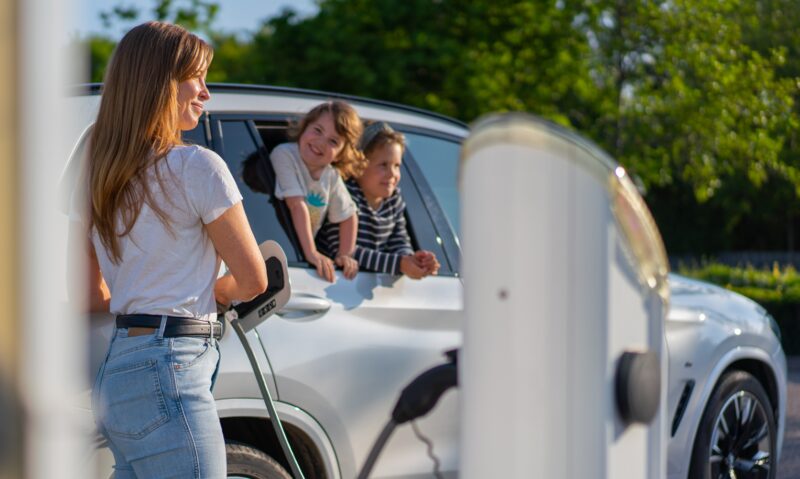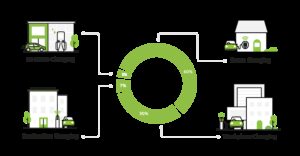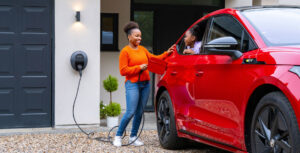How to Charge an Electric Car
The ultimate guide on how to charge your electric car, covering the places you can top up your battery and how to start charging once you are there.
Last updated: Aug 13, 2025 • 8 min read

Summary
To charge an electric car, you’ll need to plug it into a charging point. In the UK there are four main places you can find these; at home, at work, at public locations and at service stations.
- You’ll sometimes need to take your own separate charging cable with you.
- Most EV drivers plug-in to a chargepoint whenever they park to stay topped up.
- Sometimes drivers need to charge en route, using higher powered chargers.
- Depending on the location, you can start charging simply by plugging in, or by using an app, contactless card or RFID card.
Tip: You can read our user guides for instructions on how to charge your car at home using our home charger or on the Pod Point Network.
The charging ecosystem
So, how do you charge an electric car? Charging an electric car is different from filling up a petrol/diesel vehicle with fuel; electric car drivers plug-in whenever they park and return to a vehicle with a fuller battery than when they left it.
It’s best to think “where do I park most regularly?” and look to use chargepoints installed in these locations. For most people that means home, then work, then your other destinations.
Occasionally you will need to drive further than the range left in your battery and need to charge en route at a high powered rapid charger.

Charging an electric car at home
As long as you have off-street parking, you can charge your electric car at home by having a dedicated home charger installed. This is usually the most convenient place to charge, particularly when you can plug-in overnight.
- A dedicated home charging point will give you the fastest possible charging speeds, typically between 10 and 30 miles of range per hour plugged in, with a 7.4kW charger being the most popular.
- It will have built-in safety features and, if it’s Wi-Fi enabled, access to additional smart features like energy monitoring and over-the-air software updates.
- Most home chargers have a cable attached, which you typically just plug in to your vehicle to start charging.
- Our Untethered home chargers are also available with a universal ‘Type 2’ socket that accepts a separate cable and plugs into your car in the same way.
- These separate cables are often provided by the vehicle manufacturer but if you didn’t receive one or need a spare, you can purchase them when ordering your home charger.
At Pod Point you can get a home EV charger, including standard installation, installed in as little as 2 hours. Shop now.

Can you charge an electric car from a normal plug?
Electric cars can also be plugged into a standard 3-pin plug at home, however it takes longer to charge and the sockets do not have the required safety features of a dedicated charger, therefore it is not considered best practice.
Tip: Even if you choose a home charger with an attached cable, you’ll still need a separate ‘Type 2’ cable to plug-in to public charging stations (with the exception of DC rapid chargers which have attached cables). Make sure to choose the right EV charging cable for your car.
Can you turn on an EV while charging?
You can turn your EV on whilst it is charging, but you will be unable to move the vehicle and the power steering will also be disabled. There are onboard systems which can still be used whilst charging such as the heating and radio, should you want to warm your car before venturing out on a particularly cold morning.
Should I charge my electric car every night?
EV car batteries have a life measured in charge cycles or 'how many times you charge the battery'. Charging small amounts everyday contributes to this and it's often better to do fewer 'big' charges where, if your daily mileage is low and you can do a few days worth of driving on a single charge, you should. If you are low on charge at the end of each day, then you should charge, if not however, there is no benefit to charging every night.
When is the cheapest time to charge your electric car?
If you're not on a dual-rate tariff with off-peak rates, it makes no difference. But if you are, check your tariff to see when the cheapest times are. Charging your EV can be one of the biggest contributors to a household's electricity bill therefore we'd highly recommend investigating a dual rate tariff designed for EDF.
Charging an electric car at work
It is highly convenient to charge at work, because, much like charging at home, your car is often parked for an extended period during the day.
Many organisations are now installing charging stations for staff and visitors as a perk, for sustainability reasons or to facilitate the switch to an electric fleet.
- Workplace chargers typically offer the same charging speeds as home charging and normally have universal “Type 2” sockets, which mean you will need to take your own cable to the units.
- Depending on your organisation’s preference, your charge may be started by simply plugging in, as with a homecharger, or by using an RFID swipe card or an app on your smartphone.
- Very occasionally your workplace might install higher powered 50kW style rapid chargers, but given the cost, these would usually be installed for highly utilised, return to base fleet vehicles, rather than employee cars.
Learn more about Pod Point's workplace charging solutions.
Company car drivers choosing a lower emissions vehicle will benefit from reduced BIK rates. Find out more about company electric car tax.
Tip: One of the most powerful catalysts for employers installing workplace chargepoints is EV drivers (and wannabe drivers) banding together and speaking to the HR team to request charge stations as an employee perk.

Charging an electric car at public destinations
You can charge your car when parked in public locations, like at the supermarket, gym, cinema, retail parks, town-centre car parks - you name it.
It’s not usually necessary to fully charge your battery at your destination, but frequent top-ups mean that you don’t run low or have to wait while your battery recharges from empty.
- Destination charging stations usually offer 7kW charging, giving 20-30 miles of range per hour plugged in for full battery electric vehicles (BEVs).
- Many of them are provided free by businesses who use them as an incentive to visit their premises.
- You’ll need to bring your own charging cable and often need to download a smartphone app to start your charge (although in some cases it’s as simple as just plugging in).
- Some older chargepoints require you to send off for an access “RFID” card, however these are increasingly being phased out, as they do not offer ad hoc access for drivers.
You can use the Pod Point map to find destinations that offer charging stations. It lets you see live availability of chargepoints and control your charge events on the Pod Point Network.
If you want to see other networks too, we recommend using Zap-Map.
Learn more about how to access public charging points.
How do I pay for charging my electric car?
You’ll likely need to download a dedicated app to access and pay for charging your electric car at a public charger. Some chargers will allow you to simply tap your card to pay via contactless or swipe your credit card to complete the transaction.
Tip: We recommend taking the time to understand how to use the chargepoint that you intend to visit before you get there. Charging networks (like us) are working hard to make the process as effortless as possible, but some planning - particularly if you are relying on the chargepoint - does go a long way.

Charging an electric car on long distance journeys or in emergencies
On long distance journeys you will find that there are times when the remaining range in your battery won’t get you to your destination.
In this scenario you can make use of the network of high power rapid chargers (43-350kW) found in motorway service stations and other locations across the UK. This is known as en-route charging.
- Because they are expensive, and dispense a lot of electricity in a short period, rapid chargers are usually offered on a paid for basis.
- The cables are always tethered to the 43kW+ units, so you do not need to bring your own cable to them.
- There are 3 rapid charge connector types, depending on your car. Modern rapid chargers offer either all 3 or at least both DC standards.
In some situations you may find that you have run low on battery from lots of local driving and need an emergency charge.
Rapid chargers are also great for this purpose and if you’re not near a motorway service station, they can be found in convenient places like supermarket car parks.
Tip: It is only when en route charging that electric car drivers actually wait to charge making short charging time imperative. With top up charging, which is by far the most common, the time it takes to charge doesn’t matter so much, so long as you can regularly plug-in.

